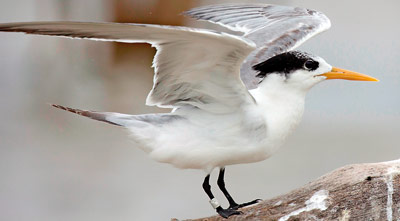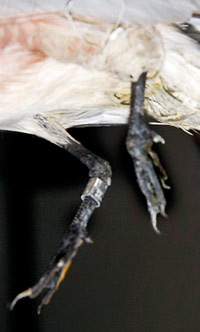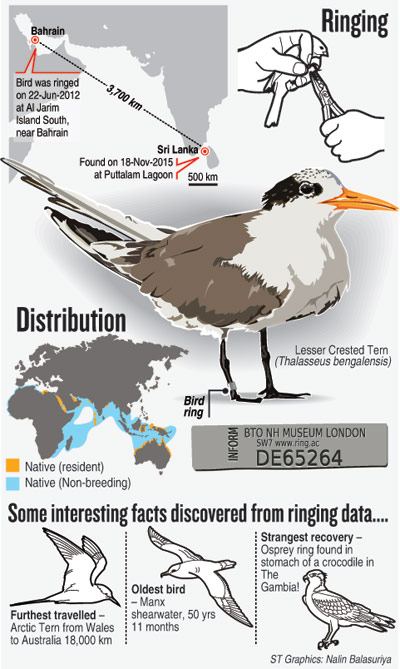News
She wears my ring, say UK bird researchers
A bird found with a ring on Puttalam lagoon last week caused puzzlement over the link between the ring and the bird. The ring was etched with the words “British Museum London” and bore other markings that were meaningless to many people.

The ‘ringed’ bird in Puttalam
One erroneous report stated, “London Museum bird accidentally lands in Sri Lanka with a ‘Stolen Ring’” and said the ring was silver.
But the bird neither visited Sri Lanka accidentally, nor had it stolen a ring. It has been identified as a lesser crested tern (Thalasseus bengalensis), a common winter migrant to Sri Lanka that can be seen this time of the year.
The ring was a piece of metal sealed around its leg by researchers in order to monitor its movement. The ring is not silver but made out of a light, non-corrosive alloy.
Bird ringing, also known as bird banding, is used by ornithologists to study the species. They catch a bird and fasten a uniquely numbered ring on one of its legs that helps to distinguish the bird individually.
The band states where the bird was ringed, and this shows experts who might find the bird elsewhere the path of its migratory flight.
The ring of the bird found in Puttalam was numbered DE65264. Following the website marked on the ring. www.ring.ac, The Sunday Times contacted the ringing team.

Pic by Hiran Prinkara Jayasinghe
The British Trust of Ornithology (BTO), which ringed this bird, said it had ringed this bird on June 22, 2012. The bird had been a juvenile at the time.
The researchers said the bird had been ringed at Al-Jarim Island in the Persian Gulf near Bahrain.
The island has a large breeding populations of bridled terns and lesser crested terns, so the bird found in Sri Lanka could have been born on that island in the Middle East. Sri Lanka lies 3700km from the ringing site.
Ringing began more than 100 years ago to study the movements of birds. While it continues to generate information about movements it also allows us to study how many young birds leave the nest and survive to breed as adults, as well as how many adults live from year to year and how many birds disperse to different breeding sites.
Collection of this information helps us to understand why bird populations increase or decrease- vital information for conservation.
The BTO organises bird ringing in Britain and Ireland and said that each year more than 900,000 birds are ringed by some 2,500 highly-trained ringers, most of whom are volunteers.
Ringing has yielded fascinating information to the BTO. The bird that travels the furthest, it found, is an Arctic tern that travels 18,000km.
BTO researchers recaptured a Manx shearwater in July 2003 and found it had been ringed as far back as 1953, making it the known longest-living wild bird at 55 years.
The lesser crested tern found in Puttalam is now in the care of the Department of Wildlife’s Anuradhapura office. Veterinarian Dr. Chandana Jayasinghe says the bird is being treated for a leg injury.
Another ringed lesser crested tern found earlier this month could, according to the data it was carrying, have been ringed by a team from Iran.
| Lanka bird ringing programme Sri Lanka now has its own National Ringing Program conducted by the Field Ornithology Group of Sri Lanka (FOGSL) in collaboration with the Department of Wildlife Conservation (DWC). This programme centered at Bundala started in 2002 and has resulted in the ringing of a large number of birds, particularly migrant birds. Migrant birds start arriving in Sri Lanka around the middle of August, ahead of the winter in their native lands. After spending around six months in Lanka they return to their breeding grounds towards the end of April the following year. The ringing exercise takes place four times a year – three during the migratory season and one in July. The three migratory season operations are conducted at the start of the wintering period (September to October); in mid-winter (December to January), and the end of the wintering period (March to April). Birds are captured with “mist nets”. The operation usually starts at dusk with these large nets being set up on a lagoon. The nets are checked periodically and the entangled birds are taken into the camp for ringing. The bird is measured, weighed and interesting marking noted. Then a small metal ring with is attached to its leg with marking stating that the bird had been tagged in Sri Lanka. The programme is now 10 years old and is expected to bring interesting results in the future. During the most recent ringing camp, researchers found a white-browed bulbul ringed 10 years ago. |

